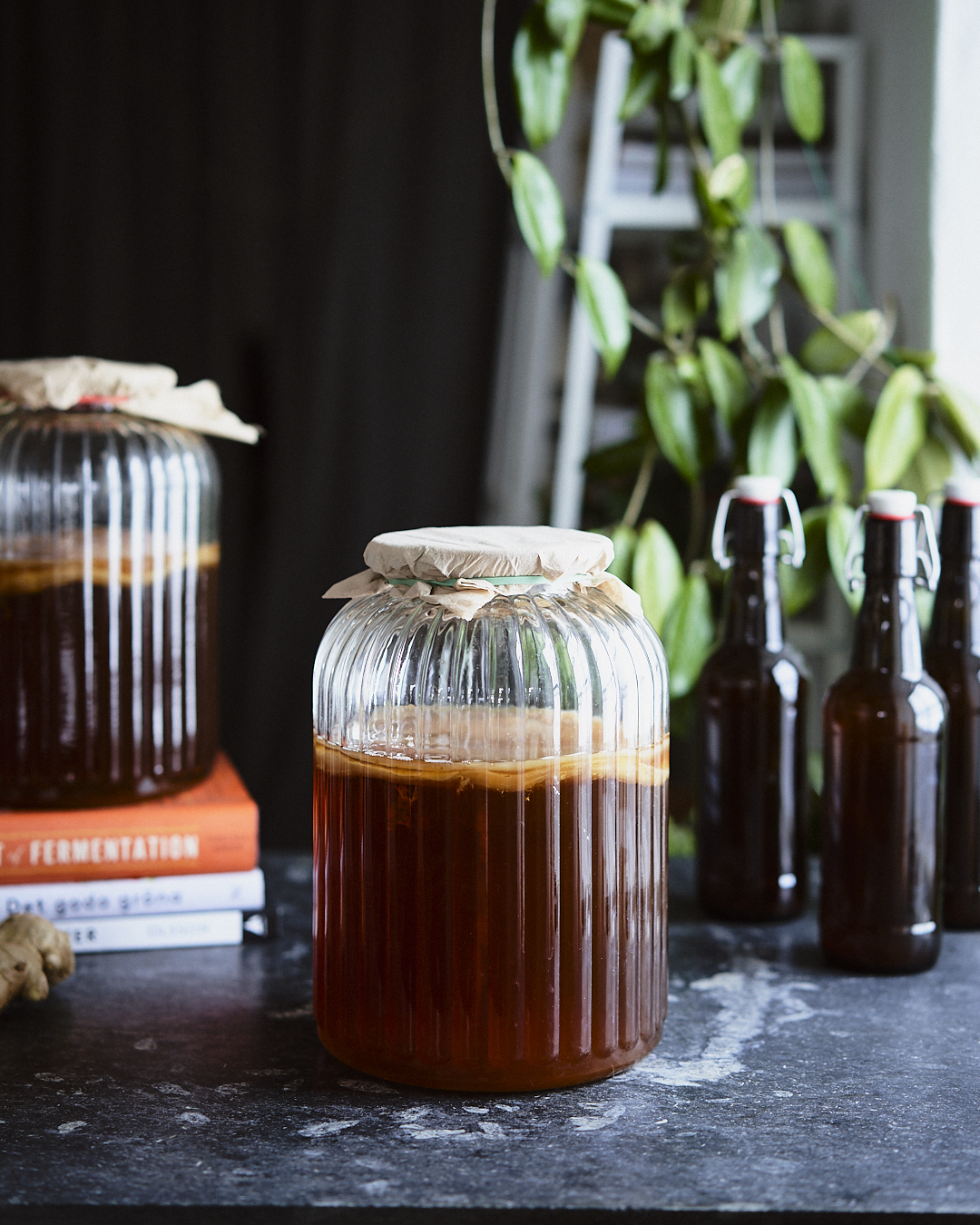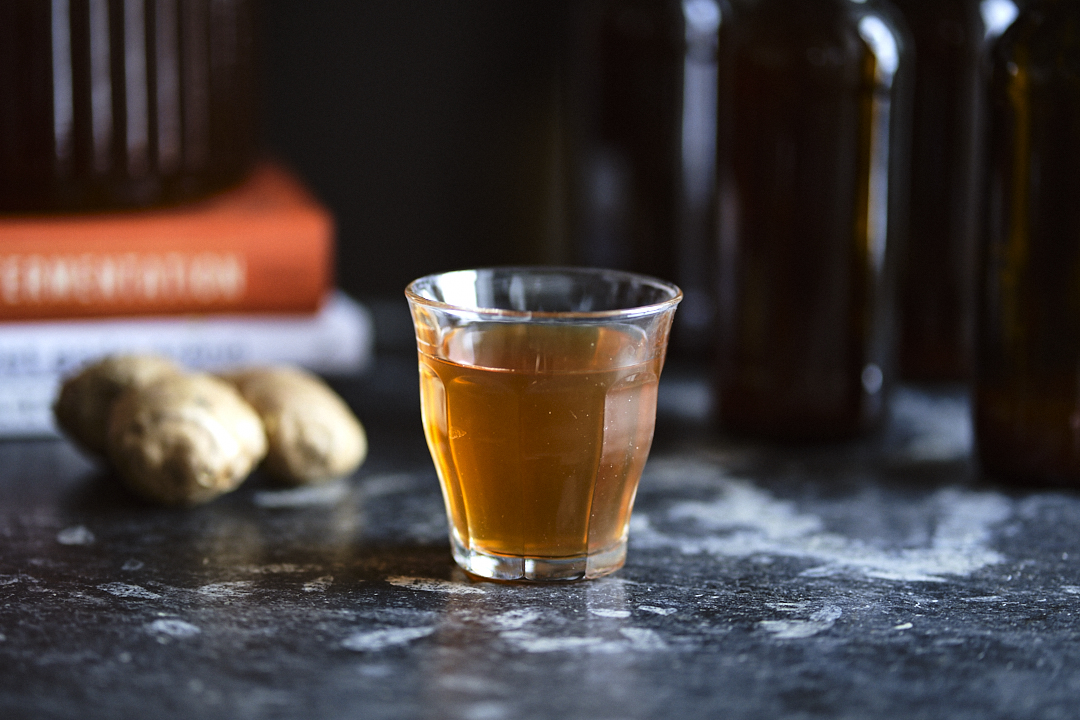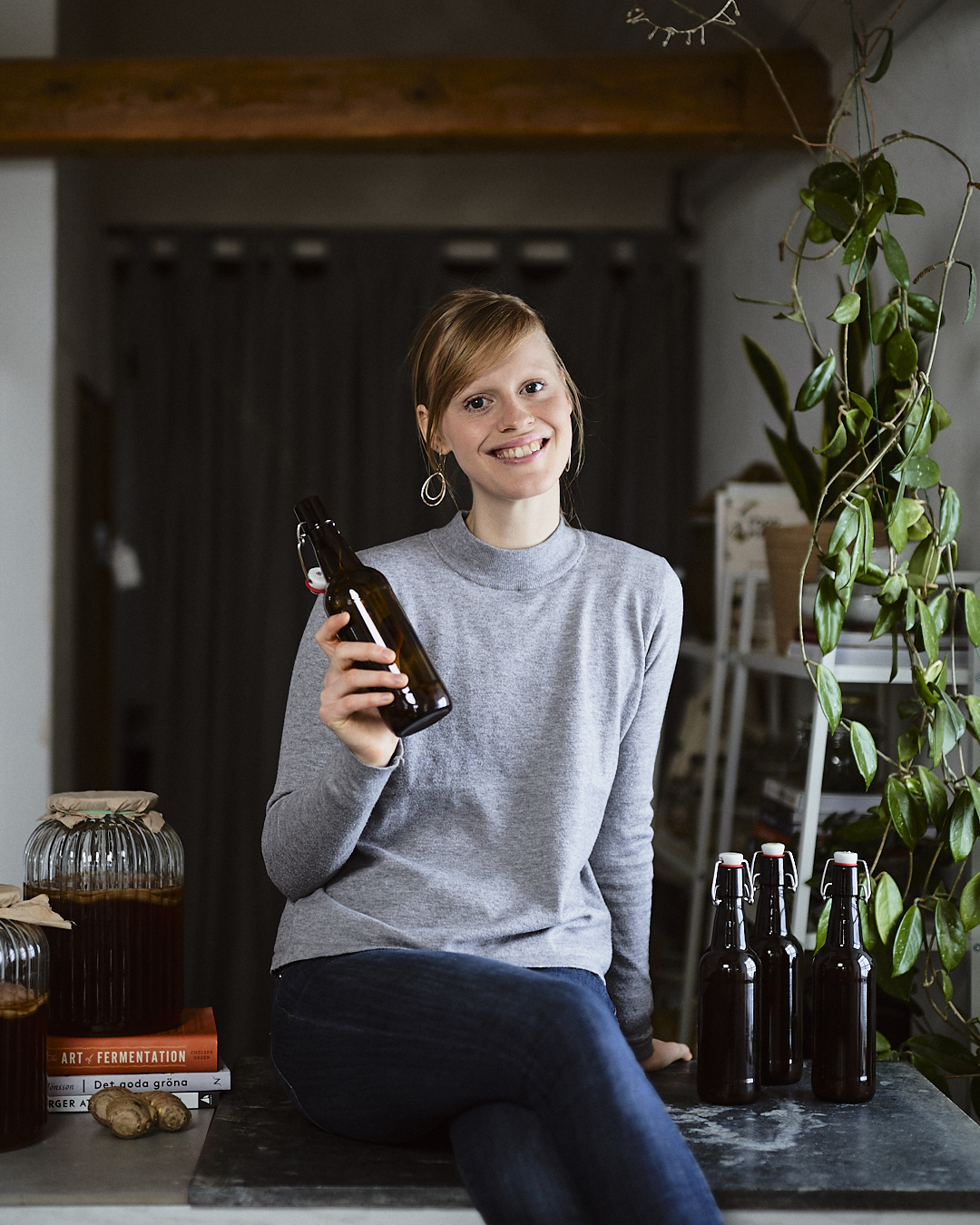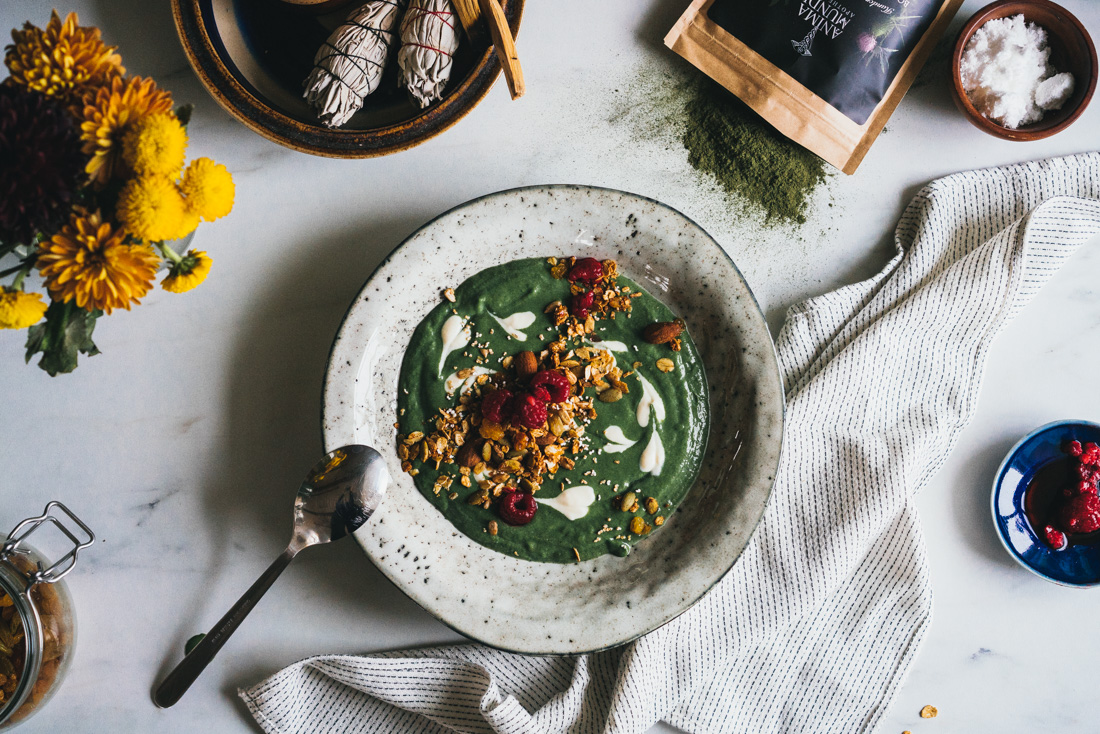So, you want to brew kombucha and maybe even grow your own scoby? I think that’s awesome. Brewing kombucha has been an adventure and so much fun for both Rob and I. Not only do we feel like we have a pet in the form of a living bacterial culture but we make our own fizzy probiotic drink. That is something I never thought I’d say! And another thing I didn’t think: it’s easy.
My initial reaction to fermentation at large, kombucha brewing included, was that is was going to be difficult, take a lot of time and go more wrong than right. In my experience having now actually done some fermenting and kombucha brewing my thoughts are completely the opposite. Almost! Because it does take time to ferment, but it’s passive time. You see, with fermentation the effort you put in is really at the start of your project. Then bacteria does the rest of the job for you as you wait. The steps to making your own ferment are also generally easy. When it comes to kombucha you are basically just making strong sweet tea in big batches and shifting liquids from one jar to another, and then maybe into some bottles. Not so complicated heh? And that it would go wrong more than right I’ve completely proved wrong in my own kitchen,especially when it comes to kombucha. Our brewing has been very easy going, nothing’s ever been spoiled and the scoby we grew back in 2016 keeps procreating and has now moved in with friends here and there.
But now that I’ve been babbling a little about my own experience with brewing this fabtastic fermented tea drink I realise that I’m using at least one word that some of you will never have heard before: SCOBY. So what is a scoby you ask? The word itself is an abbreviation for Symbiotic Culture of Bacteria and Yeast. Sounds delicious right? 😉 Well, it doesn’t need to be as it’s not something you’ll eat or drink at all (unless you wan to). It’s simply the bacterial culture that helps you ferment your tea. You can see what our scoby looks like in the video and I tell you a little bit more about what kombucha really is too.
If you want to learn how to brew kombucha and already have a scoby that you’ve acquired from a friend maybe as well as some already brewed kombucha then watch the video and you’ll be all set to get brewing. You can also find the exact measurements I talk about in the video further down this post to make it easy. However, if you don’t have a scoby yet and you would like to grow your own then scroll down and I’ll give you the low down on how to row your own. And dodn’t be nervous, this part is easy too – and a great practicefor future kombucha brewing.
Let’s get kombucha brewing friends! x

GROWING YOUR OWN SCOBY
WHAT YOU’LL NEED:
A wide mouthed jar that holds at least 3 liters, a cloth, a large rubber band, a bottle of store bought unpasteurised kombucha , black (unflavoured) tea leaves and raw cane sugar
WHAT YOU’LL NEED TO DO:
First of all you will need to make a calculation based on the size of your bottle of kombucha that you’ll use as a starter for the scoby making. You will want the ratio between the brewed kombucha to be 1:5 to the sweet tea you’ll be making next. So if you have a 0,5 liter bottle of kombucha you’ll be wanting to make 2,5 liters of sweet tea.
Next up is choosing an evening to make the sweet black tea. These are the guidelines I use when making my kombucha tea; per 1 liter of water I use 0,5 dl raw cane sugar and 1 tbsp of black tea leaves. If we continue with the hypothesis that you are making 2,5 liters of tea this would mean you’d be using 2,5 liters of boiling water, 1,25 dl raw cane sugar and 2,5 tbsp of black tea leaves.
Once you’ve boiled your water and mixed in your sugar until dissolved as well as your tea leaves I would leave the tea to cool off over night.
The next day you strain the tea through a sieve, getting rid of all the tea leaves, into your clean jar. Then you pour in your bottle of kombucha and if you want to give it a swirl because it’s fun. Then you put your cloth over the jar mouth and tighten it with an elastic band.
Now you’ll want to place your jar in a warm place, between 16-28 degrees celsius, out of direct sunlight and let the bacteria from the bottle of kombucha do it’s magic. After about 3-4 weeks you should see that a jelly looking film has been formed at the top of your tea. This is your scoby! It’s still probably quite slim and small but don’t worry it’ll grow stronger and stronger with each ferment!
PS. Don’t pour your tea out when you have cultivated your scoby, you’ll need some of it for starting your next batch of kombucha.


KOMBUCHA BREWING – GENERAL RECIPE
INGREDIENTS:
For each liter of kombucha tea you are making you will need:
0,5 dl (roughly 1/5 cup) raw cane sugar, or any other sugar you would like to use,
that is a 1:20 ratio
1 tbsp black tea leaves
1 dl already brewed kombucha, that is a 1:10 ratio
If you wish to flavour your kombucha you do this in the second ferment as I show you in the video. The most obvious way to change the taste of your kombucha is by trying different teas. You can choose between black, green and white tea leaves. However they cannot be flavoured or herbal.
METHOD:
You can see the full method I use for the first and second ferment in the video.
One thing I would like to add is to be careful when you opened any bottled kombucha, especially if you are trying a new recipes, as the carbonation can sometimes be fierce. This also applies if you’ve left your bottles out for the second ferment for more than 3 days. What I mean by fierce is that you could get a kombucha water feature in your kitchen when you open it. So if you are unsure place the bottle in your sink with a cloth over it as you open!


TROUBLE SHOOTING
Before I start this section I would just like to say that while fermentation can sound a little freaky, bacteria and all, it really is pretty straight forward and safe. If you want to try fermenting but have been unsure about it because of the bacteria aspect I encourage you to let go of that fear and give it a go. It’s fun, flavoursome and fantastic! Here are some things you might be wondering and other things that can be good to know.
Fermentation seems to never start?
This could be because of various reasons. One could be that your starter, the already brewed kombucha you added to your vessel was not viable meaning it didn’t create the right environment for fermentation. It could also be that you put it together when your tea was still too warm or because your keeping your jar in a place that’s too cold. If so find a warmer spot for it and see what happens.
Why is my scoby sinking to the bottom?
Sinking can be a sign that the scoby/mother is not healthy. It can be that the scoby sinks when you first put it in to only a few hours later float to the top. Or at least partly float to the top. So first of all have patience. If the scoby only floats halfway up but you see a new scoby forming at the top of your liquid then this is totally okay. The next time you make a new batch simply use the new scoby. If no scoby is forming at the top and the original scoby is consistent in lying low in the vessel then you might need to revive your culture. You could try putting the scoby in half/half tea and starter (already brewed kombucha) which should kick start the building of a new scoby that you can use in the future.
My scoby is moldy, what do I do?
Discard both your scoby and the tea you were fermenting and start again. Especially if you see any trace of black mold.
Why is my kombucha so sour?
If your kombucha ends up being very sour this indicates you’ve fermented it too long. Simply shorten the fermentation time for the first ferment. You could also use overly sour kombucha as a replacement for vinegar.
Why does my kombucha taste so weak?
This could be that you haven’t feed the culture enough and need to add more sugar next time. Or you need to up the flavouring if this is where you are not get the full flavour sensation you were hoping for.
Why is my kombucha not getting fizzy after the second ferment?
The first thing I would say is that you have not added enough sweetener to kick start the fermentation. So try to add a little bit of sugar or fruit juice when bottling next time. Maybe you are also leaving too much room at the top of your bottle, 1-2 centimeters of space is enough. It could also be that the temperature in the space where you do your second ferment is too low. Somewhere dark and warm is ideal. Also before I leave this question, the carbonation of kombucha is due to natural fermentation in contrast to commercial fizzy drinks which areartificially carbonated, and therefore it is wise not to compare them as equals. Fermented drinks will be a little different, because they are a little different.
And here are some of your questions as well!
Can flavouring my kombucha diminish its health properties?
While I’m certainly no expert in this field I would say that it will do exactly the opposite. It won’t disturb the bacteri as far as I know which only means you are adding other good things to your drink that could be rich in all sorts of health properties. Like ginger which I’m using which is anti-inflammatory.
Do you have to use black tea in kombucha (I’m trying to avoid caffeine)?
When brewing kombucha only about a third of the caffeine remains when we drink it. It is true that kombucha is best made with black tea leaves, but green and white can also work. However they also contain caffeine. So why can’t we use other types of tea, herbals, to brew kombucha? Tea leaves contain certain compounds that act as nutrients and feed for the scoby. Much like the sugar feeds the scoby, so does the tea itself.
How do you know your kombucha contains the good bacteria?
For this question I asked my friend Agata who I’d classify as an expert in the fermentation scene. Her answer was that to be completely sure of the nutritional content of your drink you’d need to get it lab tested but this is not something private persons normally do as it’s very expensive and usually done by bigger companies. She recommends that to be sure you have a good bacterial diversity in your culture to buy your scoby from a professional company with lab tested cultures or contacting a brewing company directly and inquire to purchase a scoby directly from them. This means you will refrain from using my scoby making tips in this post.
How do I best create my scoby hotel?
For those not brewing regularly but wanting to keep their culture alive and healthy a scoby hotel is a good idea. It’s simply creating an environment, the same way we do when brewing, but keeping possibly more than one scoby in the same place and/or leaving it for longer periods in the tea. For best results and making sure your scoby stays healthy and happy you will want to change the tea once every month. The tea should follow the same guidelines as for brewing kombucha, i.e. making sweet tea which is then mixed with a smaller amount of already brewed kombucha.




This is so informative and helpful! I am bookmarking this page to go back to for sure. How did you learn so much about Kombucha? Do you know about any other fermented drinks?
I’m very glad you found the guide useful!
I have read up on the drink for a couple of years now and have been brewing for as long,
so I’ve just learned that way.
I also have a great friend who is super knowledgeable about fermentation who helps me along the way.
I’ve invited her onto my youtube channel so she’ll be joining soon to talk more about fermentation so stay tuned if you interested in that! 🙂
I’m a fan of kombucha, good work
I’m a fan of kombucha, good work.
Thank you, and glad we share a love for kombucha – it’s the best!
Thank you so much for this informative guide! Where did you get those big jars from? I love them so much!
Hi Malin,
After watching your video a couple of times, I decided to search for a scooby donor to start doing my own Kombucha…
Started today the 1st fermentation… so fingers crossed and wish for a good result!
Let’s see if I’m able to do it successfully 😀
Best wishes directly from Portugal!